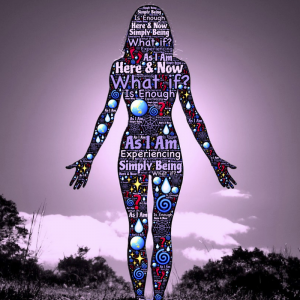
the power of presence
Oh, this life, The now, This morning, Which I can turn into forever By simply Loving What is here
-David Budhill
Identity has been called one of the most pressing issues of the 21st Century[1]-just try typing self-identity into Google and you get around 5 million hits. Who, or what, we identify with, how we root or fuse to that identity and then create or maintain the person we are-however brilliant, wild or dysfunctional that person might be, however full of insight, wisdom, blind spots and barely thought through drives and issues-this is identification, and it becomes the story we hold onto and the story we tell to the world.
The content of our identity might be different between persons and peoples, tribes and nations, but the action and result are very much the same. Our identity is often a set of preferences (what I like, what I don’t like and what I am neutral to) that help us get by, but in doing so can cut us off from growth and potential; it is not always the healthy that we identify with, it is more often the unhealthy familiar (as in difficult families). Identification forms bonds that last for decades and battles that could rage for centuries, such as the ongoing culture wars of the 21st century[2]. My Dear Story is what we tend to hold onto for dear life; our dear lives becoming synonymous, predicated onto and with My Dear Story.
But what happens when my dear story ends up costing me dearly? The story that I have might-probably will have- anchors me most fervently into the wounds of the past. If this happens, and it usually does, I’m directed by my negativity bias[3] (bad is stronger than good[4]) and lost and locked into a time of psychological pain; the story that I hoped might help has become a millstone around my neck, keeping me anxious, tense, sometimes anticipating imaginary future catastrophes. We can and do become attached to our past pain and project it into the future: dramatically attached to it.
 It’s as if, at times, we develop through different identities or “things” we identify with (class, gender, culture, religion, sexuality etc) and at some point, notably in our adulthood, this stops. It fixes into me, myself and mine, a kind of permanent self until this self meets a crisis such as a great loss or trauma. This is a problem inherent in Western culture; (D.H. Lawrence said our Western culture is like a tree with its roots in the air.) Even a constant development into further, more subtle identification is, in reality, endless iterations of the self, a kind of selfiness. It’s still the same operation, and yet there is more that we have in our creative and nested potential.
It’s as if, at times, we develop through different identities or “things” we identify with (class, gender, culture, religion, sexuality etc) and at some point, notably in our adulthood, this stops. It fixes into me, myself and mine, a kind of permanent self until this self meets a crisis such as a great loss or trauma. This is a problem inherent in Western culture; (D.H. Lawrence said our Western culture is like a tree with its roots in the air.) Even a constant development into further, more subtle identification is, in reality, endless iterations of the self, a kind of selfiness. It’s still the same operation, and yet there is more that we have in our creative and nested potential.
So we could be locked into a narrative that identifies us as a victim, a hurt one, a persecutor or reactive rescuer; we can live for decades acting out these roles on a kind of autopilot, the unprocessed and unresolved patterns of our lives running us, like a tail wagging a dog.
Is this how you really want to live?
This is akin to seeing clouds that perpetually roll by in the sky and fixating on them only, without noticing the sky that holds them, contains them and wraps around them. Ever seen a wound in the sky? No matter how bad the weather is, sky remains untroubled and untouched- yet we become content (cloud) based when there is so much more to us.
Part of the problem in this identification, this “this is me” is the reduced, contracted, tense and largely unconscious living “me” creates and maintains. Furthermore, we often don’t really know with any kind of intimacy and clarity these unconscious drives, where they come from and what they really mean. We settle for living in our heads, entertained and distracted and we treat the body as a donkey which we punish or try to keep in line. “People say they spend 5-15% of their time in awareness, 50-60% of their time in absorption, and 25-35% in abstraction”[5]. That’s a lot of time not here.
We can spend so much of our “clock” time lost in “psychological” time; of our mental and emotional states Traleg Kyabgon[6] says “nearly all of them concern the past or the future” and in these states we lose our lives in a kind of disembodied “trance of unworthiness and alienation”[7]. We need to come to our senses: literally come back to our bodies, our sense of touch, taste, what we hear, smell and see and what is known as proprioception[8], the feeling of embodied being.
Having spent so much time in our heads this will need to be approached with care and compassion, as if we are meeting a long-lost friend, a friend who will help us dissolve the notion that life is a mind driven, cognitive experience, only and that we “have” a body-we don’t, we are a body. This shifts us considerably: you are no longer fighting yourself, you are being with and befriending your deepest most authentic self, defusing from all narrative. Bring your attention here and you bring yourself to the life that’s here.
Nonidentification, defusing from our cherished, yet contracted stories brings us away from the endless clouds that obscure our living to vast sky, to the life that’s here, an embodied life where head, heart and soma-our embodiment- become integrated and in balance. And when they tip out of balance-which they will-then it’s time to rebalance. Smalley and Winston[9] write “with nonidentification you have come to a point with your emotions where they have stopped being your emotions that are causing you so much suffering and become instead the emotions-that is, something that is passing through you.”
 This is the power of presence. This is placing your attention to the here-and-now of embodied living. I direct my attention to the present, to being. What I put my attention onto or into is, in essence, my life. Not rooted or fixated in mind I can turn my attention to my embodiment, feeling the body from within. This is akin to waking up to a sunset or the shimmering ocean at noon, or indeed a vast sky of empty radiance. Traleg Kyabgon[10] writes that this is like “snow falling gently onto rocks and settling easily on the ground […] or waves crashing back into the stillness of the ocean.” This is dropping our story, like a tree drops its leaves in autumn. Does the tree feel fearful? No, it remains present in its authenticity: this is presence.
This is the power of presence. This is placing your attention to the here-and-now of embodied living. I direct my attention to the present, to being. What I put my attention onto or into is, in essence, my life. Not rooted or fixated in mind I can turn my attention to my embodiment, feeling the body from within. This is akin to waking up to a sunset or the shimmering ocean at noon, or indeed a vast sky of empty radiance. Traleg Kyabgon[10] writes that this is like “snow falling gently onto rocks and settling easily on the ground […] or waves crashing back into the stillness of the ocean.” This is dropping our story, like a tree drops its leaves in autumn. Does the tree feel fearful? No, it remains present in its authenticity: this is presence.
This has been called a “second tier” level[11] of living. Ken Wilber, who strongly promotes the notion of second tier says it best: “any emotion, sensation, thought, memory, or experience that disturbs you is simply one with which you have exclusively identified yourself, and the ultimate resolution of the disturbance is simply to dis-identify with it. You cleanly let all of them drop away by realising that they are not you–since you can see them, they cannot be [….] Since they are not your real self, there is no reason whatsoever for you to identify with them, hold on to them, or allow yourself to be bound by them”[12].
This is presence and this is the power of presence, of embodied attention, awareness, creativity and play.
Identification fuses, presence defuses. Presence wholes us.
With practice we can allow our thoughts and emotions to drop into our body and allow an integration of thoughts-emotions-body. This in turn allows us to be with our experience in a fuller way, owning what we have come to disown and come to reject: the life of the body and the power of presence. If this experience is held cognitively or emotionally only, then it often gets stuck, for it is not lived through and let go of (passed through you) and hence we remain stuck: at best we are given a kind of respite from our difficult thoughts and thinking, but they return.
Notice your minds tendency to wander, its compulsive habit to slip into the past and the future, into autopilot and distraction. Come back to your senses, to your body breathing here and now, notice the sheer presence inherent in your felt experience, the simple yet powerful feeling of being here; the past falls away and you live the life that’s here.
Bring your attention here. Ask yourself what’s happening right now, inside and outside me? Not yesterday, not tomorrow, but right here, right now. Not your idea of what could be happening-that’s merely a concept or construction and takes away the reality of the life that’s here, but your actual felt experience of right here, right now. Being here is being attuned, aligned to your senses, your embodied living. Presence is not identification, presence is a direct, embodied experience that compassionately embraces all; that is its power-it shifts us into a vast sky of freedom[13].
Jon Kabat-Zinn[14] calls this “a moment of pure presence, beyond striving, beyond mere acceptance, beyond the desire to escape of fix anything or plunge ahead, a moment of pure being, no longer in time [….] a moment in which life simply is”
So:
- You are not your past or future
- You are not your pain or suffering
- You are not your thoughts, emotions or beliefs
- You are not what you identify with
You are the awareness of these things, you are being, you are the power of presence.
See
Aydashanti The End of Your World
Loch Kelly Shift into Freedom
Jon Kabat-Zinn Coming to Our Senses
Traleg Kyabgon Mind At Ease
Reginald Ray The Awakening Body
Eckhart Tolle A New Earth
[1]https://www.theguardian.com/culture/2017/mar/19/yuval-harari-sapiens-readers-questions-lucy-prebble-arianna-huffington-future-of-humanity and https://www.theguardian.com/books/2018/sep/16/francis-fukuyama-interview-trump-picks-racial-themes-to-drive-people-on-the-left-crazy and Francis Fukayama Identity: Contemporary Politics and the Struggle for Recognition
[2] Ken Wilber Trump and a Post Truth World
[3] https://en.wikipedia.org/wiki/Negativity_bias
[4] Roy Baumeister et al http://assets.csom.umn.edu/assets/71516.pdf
[5] https://www.psychologytoday.com/us/blog/out-the-darkness/201504/bringing-yourself-back-the-present
[6] Traleg Kyabgon Mind At Ease
[7] Tara Brach Radical Acceptance
[8] https://www.painscience.com/articles/sixth-sense.php
[9] Susan Smalley & Diana Winston Fully Present: the science, art and practice of mindfulness
[10] Traleg Kyabgon Mind At Ease
[11]http://integralleadershipreview.com/2521-what-is-second-tier-powers-and-perspectives-available-to-leaders-at-second-tier/
[12] Ken Wilber No Boundary
[13] Loch Kelly Shift into Freedom
[14] Jon Kabat Zinn Coming To Our Senses






Write a Comment